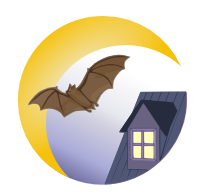What is the rabies virus?
The rabies virus causes a brain disease that is incurable and lethal to animals and humans if it is not treated in time. Luckily, there is a rabies vaccine which, when administered quickly after contact with an infected animal, stops the illness from developing. The proportion of bats infected by rabies is estimated to be 1% (Ministère de la Santé et des Services Sociaux de Québec , 2012).
In bats, rabies usually manifests itself as a host of neurological problems. The most frequently observed symptom is paralysis of the front and back limbs. Other common signs include abnormal behaviour (particularly diurnal instead of nocturnal activity), flight abnormalities such as colliding with obstacles or difficulty flying, and high-pitched screams or buzzing sounds. Thus, rabid bats are commonly found on the ground, shivering and unable to fly. Therefore, you must be especially careful with bats found on the ground (Direction de Santé Publique de Québec , 2010).
How is the virus transmitted to humans?
If a bat has rabies in its saliva, it can transmit the virus to a human through a small bite or scratch. Luckily, there is a rabies vaccine which, when administered rapidly following contact with an infected animal, stops the illness from developing. Since rabies is also transmittable to cats and dogs, it is important to have your pets vaccinated against this disease.
What should you do if you come into contact with a bat?
- If a person has had physical contact with a bat, keep the animal trapped in a secure location
- Wash your hands well with soap and water for 15 minutes
- Call the number associated with your province or territory: in Ontario: TeleHealth - 1-866-797-0000, in Manitoba: Health links - 1-888-315-9257, in Saskatchewan: Health links - 8-1-1, in Alberta: Health links - 8-1-1 (or 1-866-408-5465), in Quebec: Info-Santé - 8-1-1, in Yukon: HealthLine 8-1-1.
- If your pet has come into contact with the bat or ended up in the same room without supervision, you must contact your veterinarian
Can bats transmit histoplasmosis?
Histoplasmosis is an infectious disease which infects the lungs. It is caused by inhaling the spores of a fungus called Histoplasma capsulatum. This fungus grows on bat guano. Humans become infected by breathing in the spores in the dust created by disturbing guano. The spores settle in the lungs. Around 90% of infected people do not show any symptoms. There are three forms of histoplasmosis: the benign form, which is similar to a flu and can heal without treatment, the disseminated form, which affects other organs and can be more difficult to treat, and finally the chronic form which, resembles the symptoms of tuberculosis. If left untreated, this form can be fatal. In most cases, histoplasmosis does not require any treatment other than antifungal medication. The absolute number of histoplasmosis cases in Canada is not currently known. However, the disease is thought to be absent from Western Canada (i.e. Yukon and BC), as there have been no documented cases. The infection occurs most frequently in the St. Lawrence River Valley, where 20-30% of the population tests positive (Canadian Centre for Occupational Health and Safety (CCOHS)).
Dovecotes and chicken coops seem to constitute the most significant source of histoplasmosis infection, but humans can sometimes acquire the infection by being in contact with bat guano, especially in hot and humid caves, which contain thousands of bats. Usually, this fungus does not survive in hot and dry attics; however in order to avoid any risk of contamination, certain precautions are recommended. When droppings are found in a building, it is advisable to disinfect the floor. In order to avoid dust inhalation, wear a respiratory protection mask with class N-100 (high efficiency) particle filters, approved by the United States National Institute for occupational safety and health (NIOSH) (for example, see here). The mask must be properly fitted in order to be effective. Make sure to always wear gloves.
Precautions to limit the transmission of disease
- Always wear thick gloves when touching bats
- Disinfect your gloves after handling bat
- Wear a N-100 mask (see above) when entering into a place where there are lots of bats
- Before removing guano from an area, make sure to wet it to reduce dust

